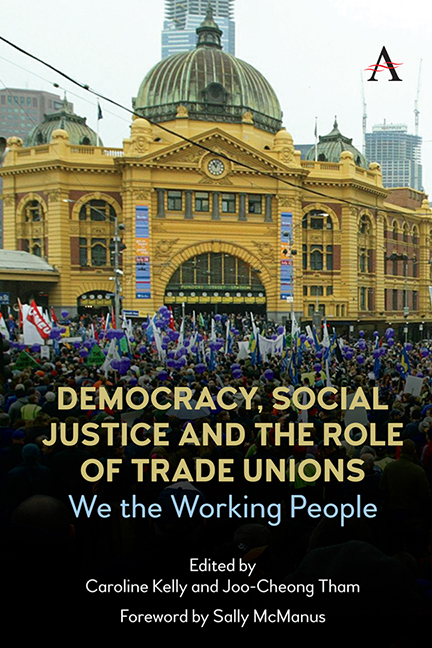Book contents
- Frontmatter
- Contents
- Foreword
- Acknowledgements
- Chapter 1 Democracy and Social Justice as Organising Principles
- Chapter 2 Economic Democracy, Workers and Unions
- Chapter 3 Nobody Owns the Future
- Chapter 4 Regulatory Approaches to the Internal Affairs of Trade Unions in Australia: From Democratic Control to Corporate Accountability
- Chapter 5 Trade Unions and the Regulation of Election Funding: Between Libertarianism and Egalitarianism
- Chapter 6 Trade Unions and Precarious Work: In Search of Effective Strategies
- Chapter 7 ‘Is There an App for That?’ Worker Representation, Unions and the Gig Economy
- Chapter 8 Temporary Migrant Workers and Trade Unions in Australia: A Complex Relationship
- Chapter 9 Unions, Fossil Fuel Exports and a Just Transition
- Chapter 10 Trade Agreements, Labour Rights and Democracy
- Chapter 11 Trade Unions, Labour Law and Democratic Socialism: The COVID-19 Crisis in the United Kingdom
- Notes on Contributors
- Index
Chapter 4 - Regulatory Approaches to the Internal Affairs of Trade Unions in Australia: From Democratic Control to Corporate Accountability
Published online by Cambridge University Press: 18 November 2021
- Frontmatter
- Contents
- Foreword
- Acknowledgements
- Chapter 1 Democracy and Social Justice as Organising Principles
- Chapter 2 Economic Democracy, Workers and Unions
- Chapter 3 Nobody Owns the Future
- Chapter 4 Regulatory Approaches to the Internal Affairs of Trade Unions in Australia: From Democratic Control to Corporate Accountability
- Chapter 5 Trade Unions and the Regulation of Election Funding: Between Libertarianism and Egalitarianism
- Chapter 6 Trade Unions and Precarious Work: In Search of Effective Strategies
- Chapter 7 ‘Is There an App for That?’ Worker Representation, Unions and the Gig Economy
- Chapter 8 Temporary Migrant Workers and Trade Unions in Australia: A Complex Relationship
- Chapter 9 Unions, Fossil Fuel Exports and a Just Transition
- Chapter 10 Trade Agreements, Labour Rights and Democracy
- Chapter 11 Trade Unions, Labour Law and Democratic Socialism: The COVID-19 Crisis in the United Kingdom
- Notes on Contributors
- Index
Summary
The internal affairs of Australian trade unions have long been the subject of detailed statutory regulation. The early federal conciliation and arbitration system, which was premised upon the recognition and facilitation of trade unions, laid the groundwork for the introduction of a range of legislative provisions concerned with internal union governance. By the late 1970s, there was an extensive legislative regime in place to ensure that the collective institutions supported by the industrial relations framework were themselves regulated and, in particular, controlled democratically by the rank-and-file membership. To this end there were, for example, provisions that imposed upon trade unions electoral controls, controls on the content of union rules and a mechanism to require the performance of those rules. Those provisions were frequently litigated and, by the 1980s, were the subject of an increasingly large body of case law.
At this time, the legislation and its application by the courts was underpinned by three key democratic principles: representative democracy in union leadership; the fullest possible participation by union members in the affairs of the union; and prevention of the arbitrary exercise of discretionary power. With respect to the third principle in particular, one can see the influence of techniques that we might usually associate with the field of administrative law at play. The case law reveals that decisions made by trade union decision makers were subjected to ultra vires type testing and administrative law standards of procedural propriety through the application of the principles of natural justice.
At the same time, however, a secondary regulatory goal was emerging: the accountability of trade unions and their officials, particularly with respect to financial matters. To this end, the legislature and the courts began to draw on regulatory techniques and principles typically associated with corporations and fiduciary law. The legislation contained detailed provisions requiring the keeping of accounting records and financial auditing. The courts likened union officials to company directors and found that they were the donees of fiduciary power.
In recent decades, the regulatory orientation has shifted. Since the late 1980s, numerous cycles of legislative change have fundamentally altered the position and role of trade unions in the industrial relations system and society more generally.
- Type
- Chapter
- Information
- Democracy, Social Justice and the Role of Trade UnionsWe the Working People, pp. 49 - 76Publisher: Anthem PressPrint publication year: 2021

